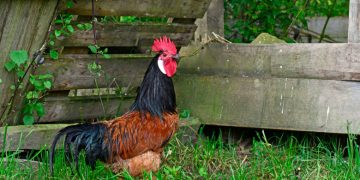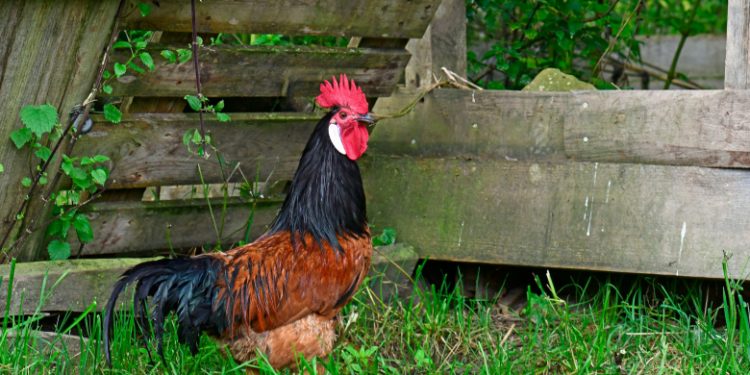The Vorwerk is a breed of German hen of good size, recognizable by its very contrasting two-tone plumage, fawn on the body and black on the head and tail. A good layer, this rustic and calm cocotte also exists in a dwarf version.
Physical peculiarities
The Vorwerk hen is a powerful and compact bird. Its back is wide, like its head which is also well furnished with feathers. His barbels are red. Its plumage is soft and shiny. The rooster is particularly elegant, with its black feathers with green highlights lying on the tail.
Egg size: 55/60g. Cream colored shell. Dwarf: 40 g
Plumage: fawn plumage with black camail and tail.
Eyes: orange-red irises.
Beak: small, arched, horn-coloured, brown, almost black in the cock.
Crest: simple, bright red, very straight, of medium size, it goes from the beak to the middle of the skull.
Chest: deep and rounded.
Mumps: white, small.
Tarsi: medium, slate blue color, four toes.
Behavior and character
Vorwerk hens are alert and active, but generally docile. It is a friendly and relatively calm chicken breed that is easy to handle and tame, making it the ideal breed for beginner breeders. The Vorwerk have good exploration skills. If you offer them an enclosure with rich soil, they will spend their days with their beaks in the ground looking for insects and will not have time to get bored.
Quite rarely, roosters are tolerant of each other and it is therefore possible to keep more than one rooster in your coop without the risk of a fight.
Feed
The Vorwerk hen is a good gleaner, so she is able to find good doses of protein in the ground by pecking insects (eggs, larvae, worms, etc.). Moreover, it is not the most greedy of hens, it is often acclaimed by breeders for this. She still cannot meet her nutritional needs on her own. She is satisfied with a conventional feed for laying hens. Either provided by pellets for layers, or by a mixture of cereals rich in protein and amino acids (wheat, corn, oats, barley, etc.). Don’t forget to add extra calcium to form the egg shell. The most widely used supplement is crushed oyster shell meal.
Reproduction
Vorwerk breed chicks grow rapidly and reach adult size fairly quickly. However, the hen is fertile rather late, she begins to lay eggs around 7/8 months. It is a fairly average brooder (preferably during the summer) that will let its young live their lives as soon as possible.
These hens from Germany are considered a cold-hardy breed that will continue to lay medium-sized light brown eggs all winter long.
Health
The Vorwerk is a rustic hen that shines with its resistance to climatic conditions and diseases. With good hygiene in the hen house and clear water in the drinker, your pullet should be doing like a charm for many years. Make sure that your hens are vaccinated so that they are spared from common diseases in gallinaceans (Marek, Newcastle, smallpox, etc.).
Place of life
Being a breed of hen that is very good at foraging, the Vorwerk is a good choice for free range keeping. Even if their calm nature allows them to manage so well in confinement, it would be a shame to lock up these perfect backyard hens in a chicken coop. They resist the cold as well as the rain well, they will just need a shaded area in the middle of summer.
Note that they are fairly good-flying hens, so proper fencing is needed to prevent them from escaping.
Breed History
The Vorwerk breed is not particularly old. She was named after Oskar Vorwerk, the breeder who created her. His intention was to develop a breed of hens which were attractive, of good size, easy to keep and which were good layers.
It was in 1902 in Hamburg that Oskar Vorwerk set out to create this new breed of poultry, which was more productive than the Lakenvelders he had been raising until then.
His primary goal was to change their plumage from white to fawn so that dirt was less visible. Indeed, the region was at the time full of coal mines whose fallout made the hens gray.
The breeds used to develop the Vorwerk would be the Lakenvelder, the Orpington, the Hittfeldern (today called Ramelslohers in Germany) and the Andalusian. This alloy created a more profitable bird for smallholders: a bird that would provide a good number of eggs with a good food to egg ratio.
Oscar Vorwerk first exhibited his hens in 1912 as new varieties. Breed standards are established th












